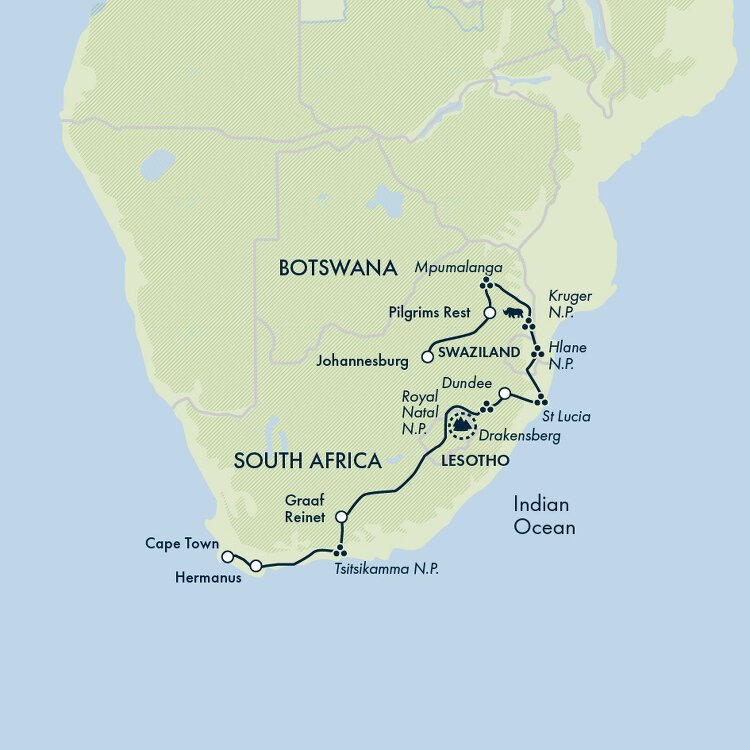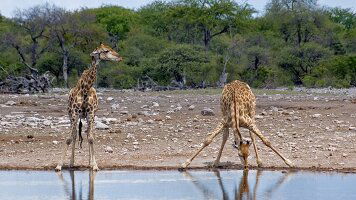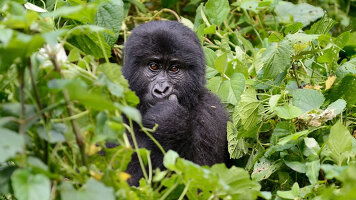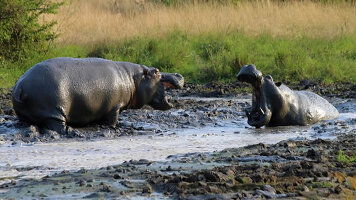Overview
Itinerary
Arrive in Cape Town any time today. The rest of the day is free to relax or explore the city. Cape Town sits in one of the most beautiful locations of any of the world's major cities with the impressive bulk of Table Mountain as its backdrop and Table Bay in the foreground. The city is a mix of cultures as people from Europe, Africa and Asia have all settled here (either voluntarily or forcibly) over the centuries. The city is a blend of Europe and Africa and a great place to watch the world pass or visit various sites and museums. Stay: Neigbourgood Castle Hotel (or similar)
After an early morning breakfast, we drive via the coastal suburbs of Clifton, Camps Bay and Hout Bay and then over Chapman's Peak Drive to the Cape of Good Hope Nature Reserve. The reserve is home to elands, springboks, wildebeest, baboons and ostriches. Rugged cliffs, unspoiled beaches, shipwrecks and beautiful flora are the main features of the reserve. We also visit the Cape Point lighthouse.
In the afternoon, we take a one-hour walk that is almost entirely downhill. Our destination is the Cape of Good Hope with a detour to Diaz Beach. The trail ends at the Cape of Good Hope signboard. We then return to Cape Town, passing through the former Royal Navy base town of Simon's Town and a visit to the resident penguin colony (optional). Our driving time today is approximately three to four hours (125mi/200km). Stay: Neighbourgood Castle Hotel (or similar) (B).
The day is free and an optional trip to Robben Island, site of Nelson Mandela's incarceration during the apartheid period, is highly recommended. Weather permitting, a cable-car ride to the top of Table Mountain is a must. Stay: InnsCape on Castle Hotel (or similar) (B).
Leaving Cape Town, we drive to the vineyard region of Stellenbosch where we have the option of visiting wineries and doing some wine tasting. We then continue towards Hermanus driving via Gordon's Bay. There is always a good chance of seeing whales in season. Hermanus is an interesting little town, rightly famous for delicious seafood – a visit to one of the great restaurants in the evening is highly recommended. It is also widely regarded as the best place on Earth for land-based whale watching from August to November. Our drive time today is approximately three to four hours (120mi/190km). Stay: Neighbourgood Castle Hotel (or similar) (B/L).
Today we drive along the beautiful Garden Route coastline via the cultivated fields of the Western Cape Boland and the town of George towards the Tsitsikamma National Park. The route is stunning and follows the ragged coast passing through small fishing villages and seaside resort. This national park, at the mouth of the Storms River, protects the indigenous forests as well as the marine life 50km out to sea. We stay at a beautifully positioned camp with the waves breaking a stone's throw away. Our driving time today will be approximately 6-7hrs (500kms). Stay: Tsitsikamma Storms River Huts (or similar) (B/L/D).
Our second day in Tsitsikamma is free to enjoy the beautiful setting. There are a range of optional activities including walks to the Storms River gorge and along the rocky coast, snorkelling, sea and river cruises and a tree canopy tour through the forests. In season, approximately August to October, the marine park is home to a population of migratory whales. Stay: Tsitsikamma Storms River Huts (or similar) (B/L/D).
We head over the Kouga and Baviaanskloof mountains as we head towards Graaff Reinet. This small 19th-century town is set in the middle of the Karoo National Reserve and is a stopover on our way to Lesotho. Our driving time today is approximately four to five hours (242mi/390km). Stay: Obesa Lodge (or similar) (B/L/D).
Today is a long day's drive as we traverse the Great Karoo and enter Lesotho. This mountainous kingdom has been shielded from outside influence over the generations and the Bastho people historically used this strategic location as a defence against events on the plains below. Our lodge in this rugged, mountainous region provides the ideal opportunity to experience Lesotho culture. Our driving time today is approximately seven to eight hours plus time at the border (330mi/530km). Stay: Malealea Lodge (or similar) (B/L/D).
The day is free to relax and experience the unique culture of Lesotho. Mountain ridges protrude into the town and an optional day pony trek to a local village is recommended. Alternatively, the craft shops and markets can be an enjoyable way to pick up African souvenirs. Stay: Malealea Lodge (or similar) (B/L/D).
Today is a long day's drive as we travel through Lesotho and exit at the Maseru border post. We then travel through the eastern farmlands of the Free State before driving through Golden Gate National Park. We continue to the Northern Drakensberg, our base for the next two nights. The Drakensberg is a basalt escarpment forming the border between Kwa Zulu-Natal and Lesotho and continuing into the Free State. It means Dragon Mountains, but the Zulu named it Ukhahlamba (the Barrier of Spears). Our driving time today is approximately five to six hours (250mi/400km). Stay: Alpine Heath (or similar) (B/L/D).
We spend a full day in the mountains where our route has us walking for approximately five to six hours into a natural amphitheatre, following the Tugela River past protea trees. The protea is the national flower of South Africa and the nickname of their cricket team. Our driving time today is approximately one hour (31mi/50km). Stay: Alpine Heath (or similar) (B/L/D).
Today we drive through the Natal midlands and to Dundee. En route, we stop at Rorke's Drift to learn about the famous battle that took place here and featured in the Michael Caine film Zulu (1964). The small cluster of buildings isolated in the enormity of the African Bush is a moving reminder of this troubled time. Our driving time today is approximately four to five hours (155mi/250km). Stay: Battlefields Country Lodge (or similar) (B/L).
Today we head for the Indian Ocean and the small town of St Lucia on the shores of a lake renowned for hippos, crocs and birds. Our driving time today is approximately four to five hours (195mi/315km). Stay: Shonalanga Lodge (or similar) (B/L).
In the early morning, we spend two hours exploring Lake St Lucia by boat, with an excellent chance of seeing some of the many resident hippos, crocodiles and fish eagles. From here, it's a short drive to Cape Vidal, a long stretch of beach along the Indian Ocean where we spend the afternoon relaxing on the beach or walking to Mission Rocks (please note, the walk to Mission Rocks is only possible at low tide and can take about four hours' return). Alternatively, there are several optional activities available, including whale watching (in season: June to November) or sunset and night game drives on the western shores of the lake. Our driving time today is approximately two to three hours (47mi/75km). Stay: Shonalanga Lodge (or similar) (B/L/D).
Today we head into our third country, Eswatini (Swaziland), and overnight in the king's old hunting grounds, now the beautiful Hlane Royal National Park.
In the afternoon, we can leave the vehicle for a nature walk (optional). Seeing animals and tracks outside the confines of a vehicle is a thrilling experience and gives us the chance to see and hear the variety of smaller animals and birds that are often passed by on game drives. Our driving time today is approximately four to five hours (185mi/300km). Stay: Hlane Lodge (or similar) (B/L/D).
We cross back into South Africa and head towards Kruger, the most famous national park in Africa. It was established by president Paul Kruger in 1898 and has arguably the greatest variety of animals of any park in Africa, with lions, leopards, elephants, buffalos, black and white rhinos, plus cheetahs, giraffes, hippos and many species of antelopes and smaller plains game. The total census includes 147 mammals, 507 birds, 114 reptiles and 336 different trees. The camps are also excellent and the general infrastructure good.
If you see all the predators, you are very lucky; however, you will almost certainly see some of the classic safari giants and a huge variety of smaller mammals. We game drive through the park to the camps, where there is a chance for a swim and hot shower. We have two days in the park. On Day 17, morning and afternoon game drives are included to maximise our chances of seeing the plentiful fauna of this great park. Our driving time today is approximately two to three hours (87mi/140km) to the park entrance plus time on safari inside the park. Stay: Kruger Park Huts or permanent tented camp (B/L/D).
After game driving out of Kruger National Park, we continue to this evening's camp for an afternoon game drive in a private concession of Kruger National Park. Our driving time today is approximately four to five hours (185mi/300km). Stay: Nkambeni Tented Camp (or similar) (B/L/D).
We head out of the park and make our way towards Graskop (Mpumalanga). En route, we drive through some spectacular countryside and stop at scenic places, such as Bourke's Luck Potholes and Blyde River Canyon, the third-largest canyon in the southern hemisphere. Our driving time today is approximately five to six hours (250mi/400km). Stay: Mogodi Lodge (or similar) (B/L/D).
On our final day, we drive along good roads towards Johannesburg. The tour ends upon arrival at Johannesburg Airport and we begin our return journeys home. Drive time is around five to six hours (235mi/380km) (B).
Trip Inclusions
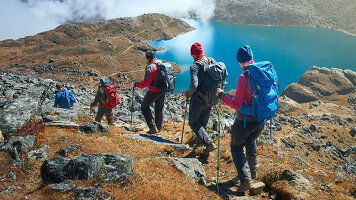
From classic small group tours & family adventures, to walking holidays, cycling trips and self-guided tours. Read more
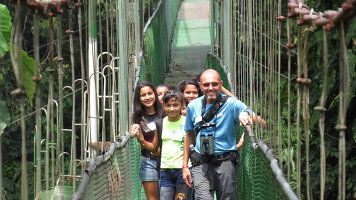
Exodus chooses their Leaders carefully. Professional, dedicated and are passionate about sharing their home countries. Read more
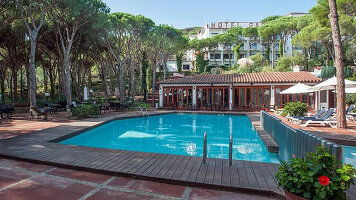
Wherever possible, Exodus chooses properties that are locally owned and that reflect the area you are visiting. Read more
Prices & Dates
There are currently no departures available on this trip. Either it's the end of the season and new departures will be released shortly, or this itinerary has been changed and will no longer continue. Feel free to contact us for information about when next seasons dates will be released or click here to view the general release dates for all destinations.
Tour & cruises prices are per person. Prices shown have savings applied, are subject to availability and may be withdrawn at any time without notice. Pricing and trip details are correct at this point in time, however are subject to confirmation at the time of booking and are subject to change by Exodus. For cruise itineraries, cabin images are sourced from the cruise-line and should be treated as indicative only. Cabin inclusions, upholsteries and room layout may differ to the image(s) shown depending on the ship selected and your sailing dates.



